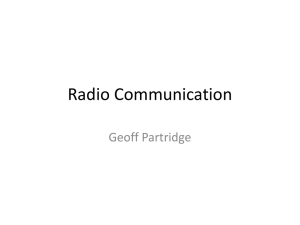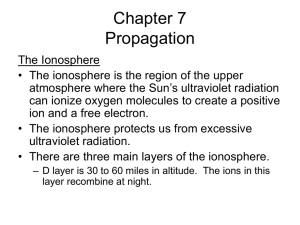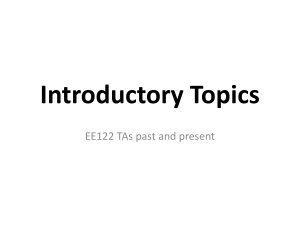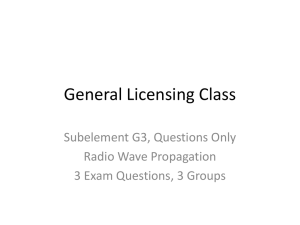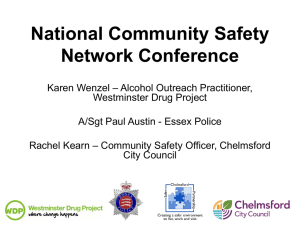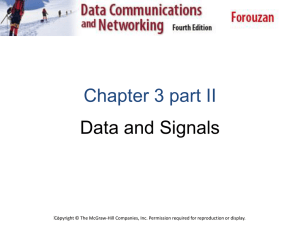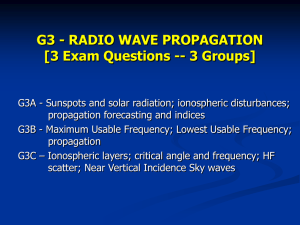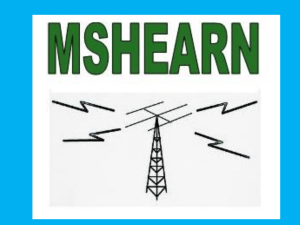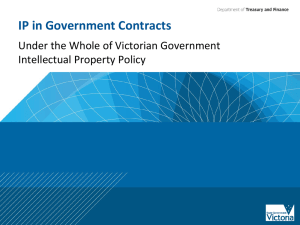Aslide16-Propagation-2 - Chelmsford Amateur Radio Society
advertisement
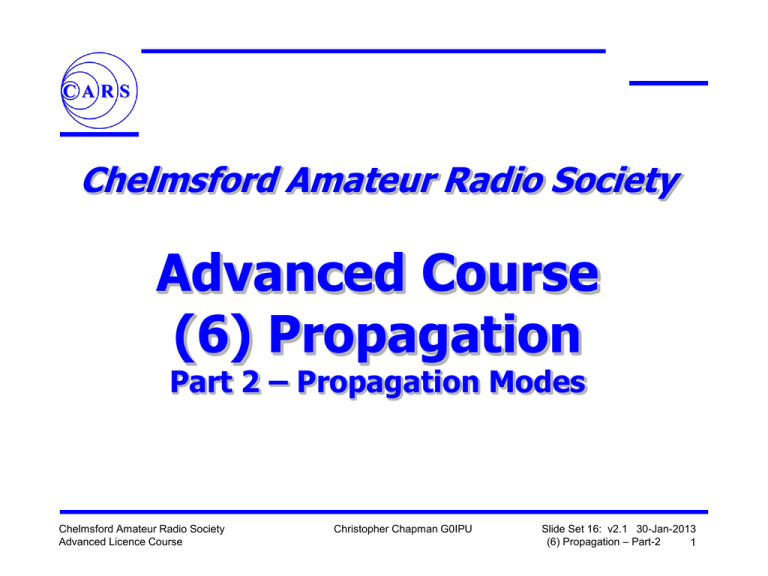
Chelmsford Amateur Radio Society Advanced Course (6) Propagation Part 2 – Propagation Modes Chelmsford Amateur Radio Society Advanced Licence Course Christopher Chapman G0IPU Slide Set 16: v2.1 30-Jan-2013 (6) Propagation – Part-2 1 Introduction Syllabus covers a wide range of propagation topics:- Key Aspects:• Solar Radiation creates the Ionospheric Layers • Understand the layers and their variation and influence on HF • Understand various ionospheric propagation modes/terms • Other affects/modes that affect VHF and higher frequencies Chelmsford Amateur Radio Society Advanced Licence Course Christopher Chapman G0IPU Slide Set 16: v2.1 30-Jan-2013 (6) Propagation – Part-2 2 The Ionosphere • The Ionosphere comprises layers of ionised gases • Ionisation occurs due to input from Solar emissions • Sources include:– Ultra-violet radiation – Solar wind particles – X-Rays • Whilst Light/UV is fairly constant, others do vary • The Earth’s rotation, orbit, and magnetic field also have a role Chelmsford Amateur Radio Society Advanced Licence Course Solar Influence is key factor Christopher Chapman G0IPU Slide Set 16: v2.1 30-Jan-2013 (6) Propagation – Part-2 3 Sunspots & Flares • A major long term variation is from the sunspot cycle (~11 year period) • More sunspots lead to higher ionisation in the ionosphere • These higher levels increase the range of refraction and usable frequencies at HF • However: If a solar flare gives a major Coronal Mass Ejection, this will upset the earths magnetic field leading to poor conditions on HF Chelmsford Amateur Radio Society Advanced Licence Course Christopher Chapman G0IPU Slide Set 16: v2.1 30-Jan-2013 (6) Propagation – Part-2 4 HF and the Ionosphere F2 F1 E VHF/UHF D 400km Earth HF 70km • • • • Ionosphere is layers of Ionised Air: 70 - 400km above earth HF is bent by ionosphere (refraction) - VHF+ passes through Four Layers: D, E, F1, F2 – created by and vary with Solar input Layers change with day/night, season, flares, sunspots etc Chelmsford Amateur Radio Society Advanced Licence Course Christopher Chapman G0IPU Slide Set 16: v2.1 30-Jan-2013 (6) Propagation – Part-2 5 Refraction C • The velocity of radio waves are slightly lower in air than in a vacuum • Ionised particles affect the velocity • They cause a small increase in velocity, causing the wavefront to veer and change direction Velocity change results in a change of direction Ionised Air A Wave in the ionosphere gets slightly faster D Normal Air B Wave Front • Higher frequencies are affected less, reducing their refraction Chelmsford Amateur Radio Society Advanced Licence Course Christopher Chapman G0IPU Slide Set 16: v2.1 30-Jan-2013 (6) Propagation – Part-2 6 Ionosphere – D Layer D Layer: ~ 80km Height • The D layer tends to absorb the lower radio frequencies • During daylight hours it absorbs most radio energy below 3-4 MHz, though it can sometimes extend up to 14MHz < > • At night, it virtually disappears, making 80 metre (3.5 MHz) DX communications usable Chelmsford Amateur Radio Society Advanced Licence Course Christopher Chapman G0IPU Slide Set 16: v2.1 30-Jan-2013 (6) Propagation – Part-2 7 Ionosphere – E Layer E Layer: ~ 120km Height • The E layer is more densely ionised and tends to refract rf • It varies with UV and X-rays, and quickly disappears, at night > < • Mainly affects up to 14MHz • Bursts of radiation can cause more intense refraction in the summer months • Sporadic E: Can occur from patches of highly ionised gas and refract 10m and VHF (6m, 4m, 2m) Chelmsford Amateur Radio Society Advanced Licence Course • Sporadic-E gives single-hop VHF QSOs of ~2000km • It is a difficult to predict short-lived event. Christopher Chapman G0IPU Slide Set 16: v2.1 30-Jan-2013 (6) Propagation – Part-2 8 Ionosphere – F Layers F Layers: ~200 - 400km • The F Layers are highest and give longer distance refraction < > • During the day it ionises into two distinct layers:• F1 at 200km • F2 at 300 - 400km • At night the two layers combine into a single F-Layer • F2 gives long distance propagation over 1000s of km Chelmsford Amateur Radio Society Advanced Licence Course • F2 enables 4000km distance in a single hop • Multi-hop gives worldwide communications Christopher Chapman G0IPU Slide Set 16: v2.1 30-Jan-2013 (6) Propagation – Part-2 9 HF Band Examples 3.5 MHz / 80 metres • Ionospheric propagation influenced by D-Layer absorption • Can be noisy, especially at night • Daytime: Ranges limited to a few 100 km • Nighttime: D-layer dissipates giving greater distances. Over 1600km may typically be achieved 21MHz / 15 metres • Sunspot Cycle has significant influence. Poor if numbers are low • The MUF can be below 21MHz – giving no propagation • Sunspot peaks will raise MUF for F-Layer DX propagation during the day and often into the evening up to 1000s km • After midnight, F-Layer thins further and propagation ceases Book has a fuller review, but only 3.5 and 21MHz is need for exam Chelmsford Amateur Radio Society Advanced Licence Course Christopher Chapman G0IPU Slide Set 16: v2.1 30-Jan-2013 (6) Propagation – Part-2 10 Critical Frequency • The critical frequency is the highest frequency that will returned to earth from an overhead vertical path • It is directly dependent on the level of ionisation above the observer – may be measured by ionospheric sounders • Sometimes called: Critical Frequency of Vertical Incidence • Typical figures are: – Summer: High 9MHz, Low 4MHz – Winter: High 14MHz, Low 3MHz • Note: Near Vertical Incidence Skywave (NVIS) exploits this for local communications coverage Chelmsford Amateur Radio Society Advanced Licence Course Christopher Chapman G0IPU Slide Set 16: v2.1 30-Jan-2013 (6) Propagation – Part-2 11 Maximum Usable Frequency (MUF) • The Maximum Usable Frequency (MUF) is the highest frequency that will be refracted over a particular path. • The MUF varies with 24hr day/night cycle, season etc • The MUF will always be higher than the critical frequency • Longer paths (with lower angles) will have a higher MUF • The MUF may be up to five times the critical frequency, depending on the angle • It is usually advantageous to use highest available frequency • The MUF varies with solar ionisation:– Overnight the ionisation steadily falls resulting in much lower MUF, to as low as around 2MHz during a sunspot minimum. – At mid-day during the maximum of the sunspot cycle, it may reach 40MHz for a long hop. Chelmsford Amateur Radio Society Advanced Licence Course Christopher Chapman G0IPU Slide Set 16: v2.1 30-Jan-2013 (6) Propagation – Part-2 12 Lowest Usable Frequency (LUF) • Lower frequencies are more liable to absorption in the D layer • Some propagation charts give a lowest usable frequency to allow for this effect • If the LUF is greater then the MUF, No propagation by the ionosphere is possible Chelmsford Amateur Radio Society Advanced Licence Course Christopher Chapman G0IPU Slide Set 16: v2.1 30-Jan-2013 (6) Propagation – Part-2 13 Skip / Dead Zone • Between the skip distance and ground wave range is a region that can not be covered • This is known as the Skip or Dead Zone • It is quite easy to observe... • Tune to a distant station in QSO with someone in the UK • The distant station may be a strong signal, but the UK station is often totally inaudible, despite being located nearer to you Chelmsford Amateur Radio Society Advanced Licence Course Christopher Chapman G0IPU Slide Set 16: v2.1 30-Jan-2013 (6) Propagation – Part-2 14 Fading • Fading is caused by signals arriving at the receiver by slightly different paths - Multipath • The path lengths will vary, changing the received phase from each path • Differences in phase cause the signals to add or cancel • SSB, CW will fade/drop out, FM can become severely distorted • If two signals are 180° out of phase, fading results in full cancellation • The paths with vary with time and propagation mode leading to variable fading • Fading rates may be slow, fast or a hybrid combination Chelmsford Amateur Radio Society Advanced Licence Course Christopher Chapman G0IPU Slide Set 16: v2.1 30-Jan-2013 (6) Propagation – Part-2 15 Propagation Modes Main Propagation modes:• Ground wave – at LF • Sky/Ionospheric waves – at HF • Tropospheric (space) waves – at VHF Shorter wavelength VHF/Microwaves can be affected by:• Ducting from moist/warm air causing ‘lifts’ • Edge-diffraction • Aurora • Meteor trails • Building scatter / multipath • Scatter from aircraft, heavy rain Chelmsford Amateur Radio Society Advanced Licence Course Christopher Chapman G0IPU Aurora Slide Set 16: v2.1 30-Jan-2013 (6) Propagation – Part-2 16 Main Propagation Modes Ground Wave • Ground wave hugs the curvature of the earth but quickly gets weaker • Range over land is relatively short – but usable below 2MHz • Losses influenced by ground conductivity – best over sea water Sky or Ionospheric Wave • Sky wave is the primary mode of propagation from 1 - 30MHz • It is very dependent on the level of ionisation Tropospheric Wave (or space wave) • Primary propagation mode at frequencies above 30 - 40MHz • Occurs below the ionosphere but above the influence of the terrain • Water vapour and temperature variations cause radio waves to refract downwards slightly, following the curvature of the earth • Enables contacts somewhat greater than line of sight Chelmsford Amateur Radio Society Advanced Licence Course Christopher Chapman G0IPU Slide Set 16: v2.1 30-Jan-2013 (6) Propagation – Part-2 17 LUF, MUF, Paths Summary Above 30MHz lost to space F2 Tropospheric Wave F1 Skip/Dead Zone E LUF Absorption Ground Wave Critical Frequency D MUF Signal Chelmsford Amateur Radio Society Advanced Licence Course Earth Christopher Chapman G0IPU Tx Station Slide Set 16: v2.1 30-Jan-2013 (6) Propagation – Part-2 18 VHF/UHF Modes • Ducts: Moist or warm air layers, often associated with high atmospheric pressure, bend or trap waves giving propagation over longer distances • Ducts can be in mid-air or just above the sea surface, but antennas need to be in the duct to get strong signals • Knife Edge Diffraction: Waves bend around corners or hill tops, enabling communication between stations that may otherwise be obstructed • Shadowing: from buildings, hills gives patchy coverage • Scatter: can give signals for unlikely paths – in between buildings, from aircraft wings, rain clouds, moonbounce etc • Meteor Scatter: Ionised meteor trails reflect signals. Good on 2m and 6m • Aurora: On 6m, 4m and 2m, SSB voice loses tonal content, giving a whisper-like sound Chelmsford Amateur Radio Society Advanced Licence Course Christopher Chapman G0IPU Slide Set 16: v2.1 30-Jan-2013 (6) Propagation – Part-2 19 Re-Cap • • • • • • • • • • • • • • Ionosphere & Propagation 11 Year Sunspot Cycle HF and the Ionosphere Refraction Ionosphere Layers: D,E,F (F1,F2) HF Band Examples: 80m (3.5MHz) and 15m (21MHz) Critical Frequency Maximum Usable Frequency (MUF) Lowest Usable Frequency (LUF) Skip/Dead Zone Fading Main Propagation Modes LUF, MUF & Propagation Paths VHF/UHF Propagation Modes Chelmsford Amateur Radio Society Advanced Licence Course Christopher Chapman G0IPU Slide Set 16: v2.1 30-Jan-2013 (6) Propagation – Part-2 20
